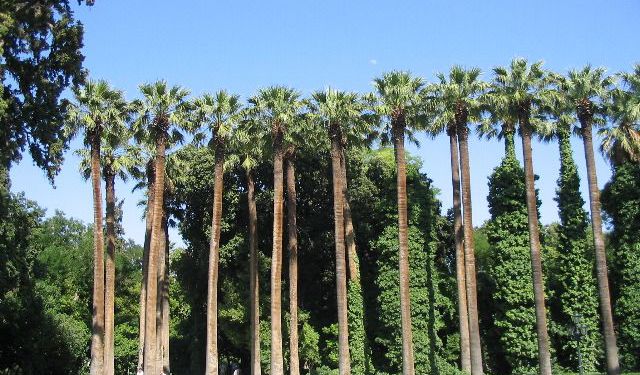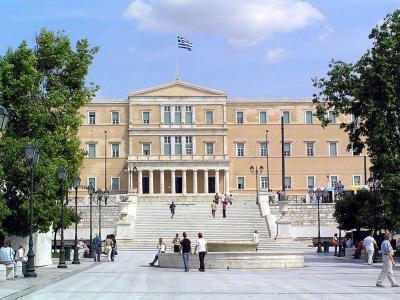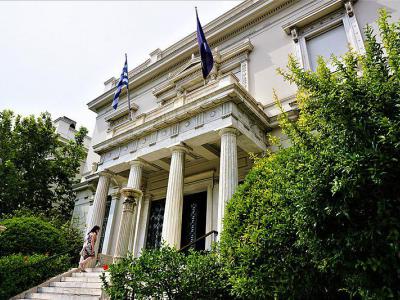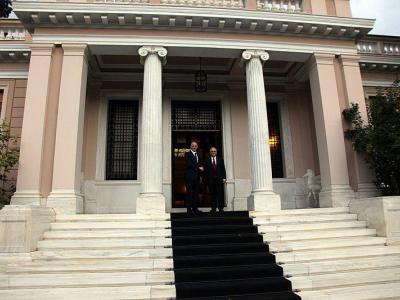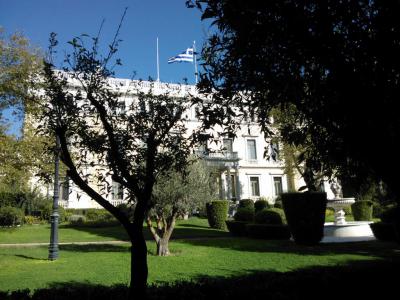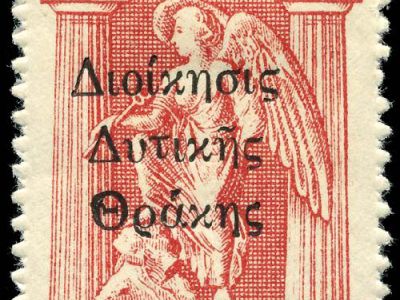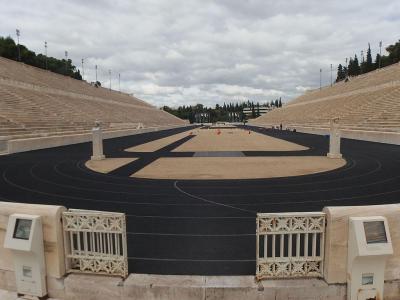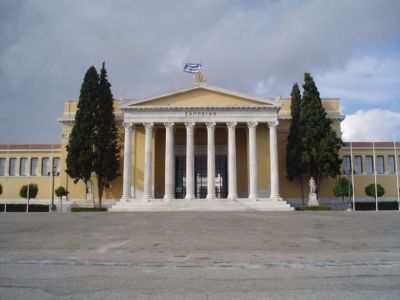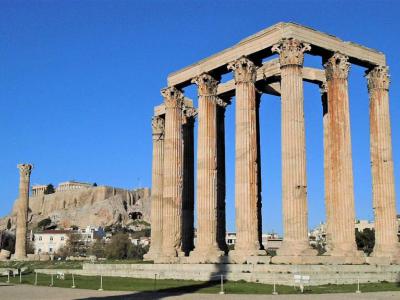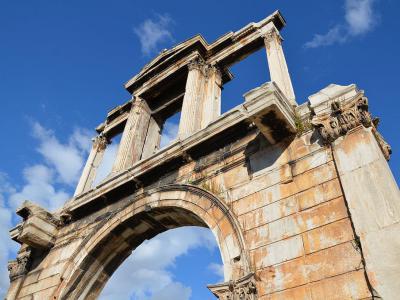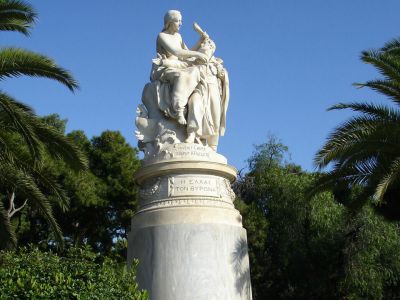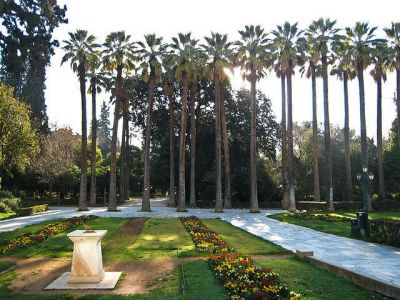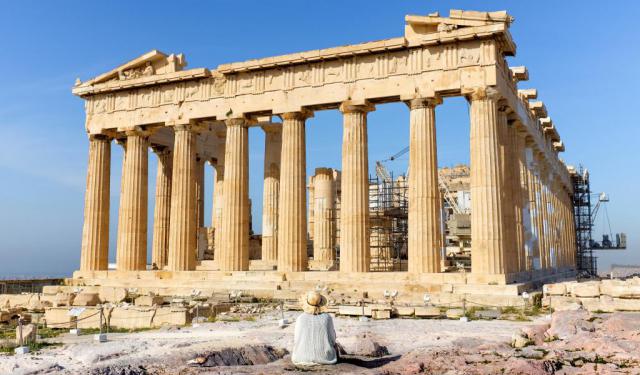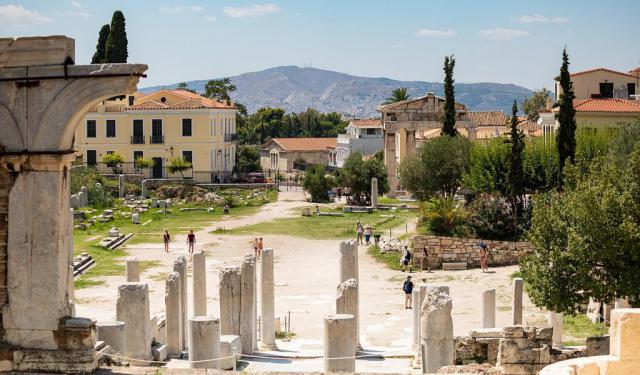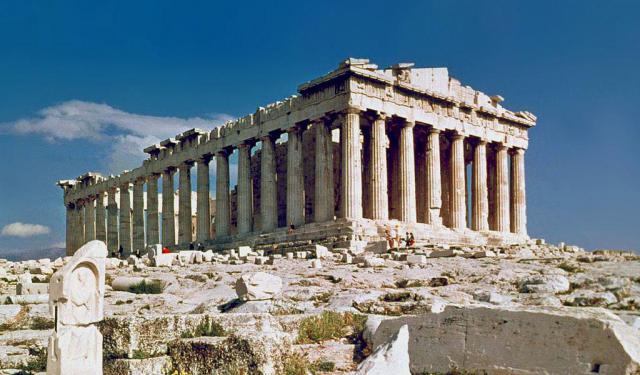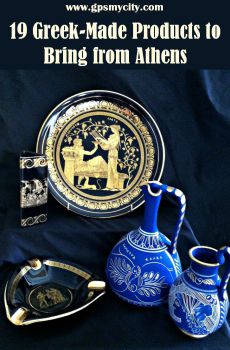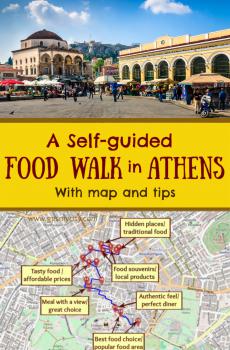Walking Around the National Garden (Self Guided), Athens
The National Garden is an impressive, historic park in the center of Athens, complete with artificial streams and duck ponds. Formerly known as the Royal Garden, it was commissioned by King Otto’s queen, Amalia, in 1838, reason why it is located directly behind the Old Palace (currently the Greek Parliament building). Not only is it a welcome refuge from the swirl of traffic just outside the gates, but strolling around its landscaped grounds will lead to quite a few brilliant attractions.
First among these is the Benaki Museum, which affords a fascinating vast reflection of Greek art in all its manifestations, and where a lovely lunch can be had on the terrace restaurant with a modern version of local cuisine. The route will then take you by the seat of the Prime Minister and the next-door Presidential Mansion, where most folks like to take a selfie with the guards.
To see where the first modern Olympic Games took place, head to the Panathenaic Stadium and the famous statue of the Discus Thrower, inspired by models from classical antiquity, opposite to it.
The Záppeion, an imposing neoclassical building designed as a national exhibition hall in 1878, is set in its own gardens, and is immediately followed by the Temple of Olympian Zeus, the largest temple ever built on Greek soil. Today only 16 columns still stand, but their Corinthian capitals have a wonderful form and elegance.
Comprising these and more, our self-guided walking tour will help navigate your way through some of the National Garden’s most alluring attractions - so wear comfortable shoes and explore at your own pace.
First among these is the Benaki Museum, which affords a fascinating vast reflection of Greek art in all its manifestations, and where a lovely lunch can be had on the terrace restaurant with a modern version of local cuisine. The route will then take you by the seat of the Prime Minister and the next-door Presidential Mansion, where most folks like to take a selfie with the guards.
To see where the first modern Olympic Games took place, head to the Panathenaic Stadium and the famous statue of the Discus Thrower, inspired by models from classical antiquity, opposite to it.
The Záppeion, an imposing neoclassical building designed as a national exhibition hall in 1878, is set in its own gardens, and is immediately followed by the Temple of Olympian Zeus, the largest temple ever built on Greek soil. Today only 16 columns still stand, but their Corinthian capitals have a wonderful form and elegance.
Comprising these and more, our self-guided walking tour will help navigate your way through some of the National Garden’s most alluring attractions - so wear comfortable shoes and explore at your own pace.
How it works: Download the app "GPSmyCity: Walks in 1K+ Cities" from Apple App Store or Google Play Store to your mobile phone or tablet. The app turns your mobile device into a personal tour guide and its built-in GPS navigation functions guide you from one tour stop to next. The app works offline, so no data plan is needed when traveling abroad.
Walking Around the National Garden Map
Guide Name: Walking Around the National Garden
Guide Location: Greece » Athens (See other walking tours in Athens)
Guide Type: Self-guided Walking Tour (Sightseeing)
# of Attractions: 11
Tour Duration: 2 Hour(s)
Travel Distance: 3.3 Km or 2.1 Miles
Author: emily
Sight(s) Featured in This Guide:
Guide Location: Greece » Athens (See other walking tours in Athens)
Guide Type: Self-guided Walking Tour (Sightseeing)
# of Attractions: 11
Tour Duration: 2 Hour(s)
Travel Distance: 3.3 Km or 2.1 Miles
Author: emily
Sight(s) Featured in This Guide:
- Hellenic Parliament House
- Benaki Museum
- Maximos Mansion
- Presidential Mansion
- Postal and Philatelic Museum
- Panathenaic Stadium
- Zappeion Hall
- Temple of Olympian Zeus
- Hadrian's Arch
- Lord Byron Statue
- National Garden
1) Hellenic Parliament House
The Hellenic Parliament is housed in a historic building that once served as home to the Greek Royal Family. Constructed in 1840 by Bavarian architect Friedrich von Gärtner, the neoclassical palace was initially the official residence of King Otto, Greece's first monarch. The construction marked the end of Turkish occupation and was funded by Otto's father, King Ludwig of Bavaria. After being damaged by a fire in the early 20th century, the Royal Family relocated to a new palace, which today serves as the Presidential Mansion.
To make it suitable as a Parliament seat, the imposing edifice underwent extensive renovations. In 1935, it became home to the Greek National Assembly and presently accommodates the offices of the Assembly's President, as well as archives and other services. Its western façade, overlooking Syntagma Square, has a Doric portico clad in Pentelic marble. In front of the building lies the Tomb of the Unknown Soldier, a memorial honoring all Greeks who have lost their lives in wars serving their country.
Tip:
Public access to the palace is open only from one side. Please note that visitors are not allowed to walk on the marble stairs. No tour guide is available.
To make it suitable as a Parliament seat, the imposing edifice underwent extensive renovations. In 1935, it became home to the Greek National Assembly and presently accommodates the offices of the Assembly's President, as well as archives and other services. Its western façade, overlooking Syntagma Square, has a Doric portico clad in Pentelic marble. In front of the building lies the Tomb of the Unknown Soldier, a memorial honoring all Greeks who have lost their lives in wars serving their country.
Tip:
Public access to the palace is open only from one side. Please note that visitors are not allowed to walk on the marble stairs. No tour guide is available.
2) Benaki Museum (must see)
Established in 1931 by Antónis Benákis and housed within an elegant Neoclassical mansion dating back to 1867, which once served as the residence of the Benákis family, this museum stands out as perhaps the sole institution that comprehensively chronicles all eras of Greek culture and history. Its impressive collection encompasses Greek arts, paintings, jewelry, regional costumes, and political memorabilia, spanning an impressive timeline of over 5,000 years, from the Neolithic era (7,000 BC) to the 20th century. The wealth of exhibits is incredibly diverse, impeccably organized, and thoughtfully curated, providing visitors with a coherent historical context. A visit is undoubtedly worthwhile, especially for those with limited time in Athens seeking a museum that encapsulates Greece's rich history.
The ground floor exhibition is thoughtfully arranged into distinct periods, encompassing prehistoric to late Byzantine art and Cretan icon painting. On the first floor, exhibits are organized by geographic origin, showcasing artifacts from Asia Minor, mainland Greece, and the Greek islands, as well as a remarkable collection of ecclesiastical silverware and jewelry. The second floor features artifacts pertaining to Greek spiritual, economic, and social life, while the third floor delves into the Greek War of Independence, modern political and cultural developments, and includes a space for temporary exhibitions.
The museum's lesser-known gems include a ground-floor gift shop and a rooftop café, the latter offering delectable cuisine and breathtaking views of the National Gardens and the House of Parliament.
Tip:
Consider visiting on Thursdays when the museum offers free admission and extends its opening hours until midnight.
The ground floor exhibition is thoughtfully arranged into distinct periods, encompassing prehistoric to late Byzantine art and Cretan icon painting. On the first floor, exhibits are organized by geographic origin, showcasing artifacts from Asia Minor, mainland Greece, and the Greek islands, as well as a remarkable collection of ecclesiastical silverware and jewelry. The second floor features artifacts pertaining to Greek spiritual, economic, and social life, while the third floor delves into the Greek War of Independence, modern political and cultural developments, and includes a space for temporary exhibitions.
The museum's lesser-known gems include a ground-floor gift shop and a rooftop café, the latter offering delectable cuisine and breathtaking views of the National Gardens and the House of Parliament.
Tip:
Consider visiting on Thursdays when the museum offers free admission and extends its opening hours until midnight.
3) Maximos Mansion
With the benefit of being located at the heart of Athens, near Syntagma Square and a stone's throw from the Hellenic Parliament, the Maximos Mansion, with its pale pink and white façade, has served as the official residence of the Prime Minister of Greece since 1982.
Founded in 1912 by Alexandros Michalinos, a prosperous shipowner hailing from the island of Chios, this grand Neoclassical edifice priorly functioned as a guesthouse for esteemed foreign dignitaries visiting Greece. Notable guests included Marshal Tito of Yugoslavia in 1955 and Margaret Thatcher of the United Kingdom in 1980.
Historically, the mansion played diverse roles, serving as the official residence of the German Admiral of the Aegean Sea during the German occupation of Greece. Post-war, it briefly assumed the role of the U.S. Ambassador's residence in Athens.
While the Maximos Mansion presently serves as the seat of the Greek Prime Minister, it does not serve as his official dwelling. Nevertheless, it welcomes visitors and showcases local artists' creations, highlighting their exceptional talent and craftsmanship.
Founded in 1912 by Alexandros Michalinos, a prosperous shipowner hailing from the island of Chios, this grand Neoclassical edifice priorly functioned as a guesthouse for esteemed foreign dignitaries visiting Greece. Notable guests included Marshal Tito of Yugoslavia in 1955 and Margaret Thatcher of the United Kingdom in 1980.
Historically, the mansion played diverse roles, serving as the official residence of the German Admiral of the Aegean Sea during the German occupation of Greece. Post-war, it briefly assumed the role of the U.S. Ambassador's residence in Athens.
While the Maximos Mansion presently serves as the seat of the Greek Prime Minister, it does not serve as his official dwelling. Nevertheless, it welcomes visitors and showcases local artists' creations, highlighting their exceptional talent and craftsmanship.
4) Presidential Mansion
Next to the National Garden and Parliament stands the official residence of the President of the Hellenic Republic. This grand mansion, formerly the dwelling of the Greek Royal Family, held this status until the 1974 referendum that marked the end of the monarchy.
Constructed during the 1890s, the three-story edifice stands as as another fine example of Neoclassical excellence, a testament to the legacy of German-born architect Ernst Ziller, who left an indelible mark on Athens during the nation's formative years.
Initially, the mansion featured a simple design devoid of elaborate ballrooms, a departure from the norm seen in other palaces. However, when the Royal Family took residence in 1909, Ziller undertook an extension project, adding a ballroom that now serves as the venue for foreign ambassadors' presentations of their credentials to the Greek President. In 1962, another extension was completed, known as the Reception Hall, which was built for the engagement of Sophia, Princess of Greece, and Prince Juan Carlos of Spain. This hall has since become the largest room in the palace.
Surrounded by beautifully landscaped gardens, covering approximately 7 acres, the palace itself is not open to the general public. Nonetheless, it is worth a visit to witness the ceremonial guards stationed outside, showcasing their impressive uniforms and routines.
Constructed during the 1890s, the three-story edifice stands as as another fine example of Neoclassical excellence, a testament to the legacy of German-born architect Ernst Ziller, who left an indelible mark on Athens during the nation's formative years.
Initially, the mansion featured a simple design devoid of elaborate ballrooms, a departure from the norm seen in other palaces. However, when the Royal Family took residence in 1909, Ziller undertook an extension project, adding a ballroom that now serves as the venue for foreign ambassadors' presentations of their credentials to the Greek President. In 1962, another extension was completed, known as the Reception Hall, which was built for the engagement of Sophia, Princess of Greece, and Prince Juan Carlos of Spain. This hall has since become the largest room in the palace.
Surrounded by beautifully landscaped gardens, covering approximately 7 acres, the palace itself is not open to the general public. Nonetheless, it is worth a visit to witness the ceremonial guards stationed outside, showcasing their impressive uniforms and routines.
5) Postal and Philatelic Museum
Established in 1978, this museum forms part of the Greek postal service, Hellenic Post, dedicated to showcasing stamps and various postal paraphernalia. Whether you're a philatelist or simply curious about the world of postage, it offers a unique and informative experience.
Within the Postal Hall, visitors can explore mailboxes, franking machines, bags, horns, and an assortment of objects used in the operations of post, telegraph, and telephone services. Mailboxes and weighing machines dating back to the 19th century are also on display, providing a glimpse into the historical evolution of postal services.
The Philately Hall houses an impressive collection of stamps, including rare specimens from the 1st Olympics, with a representation of the Head of Hermes. There is also a section devoted to stamp-printing techniques and the models used as the original subjects of stamp art.
Within the Postal Hall, visitors can explore mailboxes, franking machines, bags, horns, and an assortment of objects used in the operations of post, telegraph, and telephone services. Mailboxes and weighing machines dating back to the 19th century are also on display, providing a glimpse into the historical evolution of postal services.
The Philately Hall houses an impressive collection of stamps, including rare specimens from the 1st Olympics, with a representation of the Head of Hermes. There is also a section devoted to stamp-printing techniques and the models used as the original subjects of stamp art.
6) Panathenaic Stadium (must see)
The Panathenaic is truly a remarkable historical site, being the only major stadium in the world constructed entirely of white marble. Its origins trace back to ancient times when it served as the venue for the athletic competitions of the Panathenaic Games, dedicated to the Goddess Athena and held every four years. The stadium underwent significant transformations, with a marble reconstruction in 329 BC and later expansion and renovation in 140 AD, accommodating up to 50,000 spectators.
Having fallen into disuse and disrepair after the 4th century AD, it was rediscovered and revitalized for the modern era, playing a pivotal role in the revival of the Olympic Games in the late 19th century. Despite its smaller scale compared to contemporary Olympic venues, the Panathenaic's elegant simplicity and iconic five Olympic rings continue to inspire awe. At the entrance, you'll encounter four stones engraved with the interesting history of the Olympics from the late 19th century to the present day.
The inaugural international Olympic Games in modern history were held here in 1896, with King George I of Greece opening the ceremony. Among participants were 241 male athletes from 14 countries, competing in 9 sports and 43 events. These early modern Olympic sports included athletics, cycling, fencing, gymnastics, tennis, shooting, swimming, weightlifting, and wrestling. Since then, athletes from across the globe have convened every four years, with the tradition enduring through the tumultuous 20th century wars.
Why You Should Visit:
A captivating place to explore, and you can enhance your visit with the free audio guide provided.
The on-site museum provides an engaging exhibition on the fascinating history of the Olympics.
Tip:
Don't miss the opportunity to climb to the upper tier for stunning views of the stadium.
Having fallen into disuse and disrepair after the 4th century AD, it was rediscovered and revitalized for the modern era, playing a pivotal role in the revival of the Olympic Games in the late 19th century. Despite its smaller scale compared to contemporary Olympic venues, the Panathenaic's elegant simplicity and iconic five Olympic rings continue to inspire awe. At the entrance, you'll encounter four stones engraved with the interesting history of the Olympics from the late 19th century to the present day.
The inaugural international Olympic Games in modern history were held here in 1896, with King George I of Greece opening the ceremony. Among participants were 241 male athletes from 14 countries, competing in 9 sports and 43 events. These early modern Olympic sports included athletics, cycling, fencing, gymnastics, tennis, shooting, swimming, weightlifting, and wrestling. Since then, athletes from across the globe have convened every four years, with the tradition enduring through the tumultuous 20th century wars.
Why You Should Visit:
A captivating place to explore, and you can enhance your visit with the free audio guide provided.
The on-site museum provides an engaging exhibition on the fascinating history of the Olympics.
Tip:
Don't miss the opportunity to climb to the upper tier for stunning views of the stadium.
7) Zappeion Hall
Amidst the patriotic zeal that enveloped the newly established Greek nation, millionaire Evángelos Zappas aspired to construct a grand hall that could host world-exhibition-style events and serve as the ceremonial venue for the rekindled Olympic Games. Theophilos Hansen, who had demonstrated his neoclassical bent in his designs for the Greek Academy and National Library, was entrusted with the design of this colossal semicircular hall. Inaugurated in 1888, it was named in honor of the benefactor who funded the ambitious project.
Hansen's architectural vision embellished the hall's lengthy facade with a stately portico and an exquisite row of columns; however, the true showpiece lies within-a vast circular atrium encircled by a two-story arcade supported by an array of columns and caryatids.
During the inaugural modern Olympic Games in 1896, the Zappeion served as the venue for fencing competitions. In more recent times, it witnessed significant events such as Greece's accession to the European Union through ceremonial signings. Alongside its elegant gardens, adorned with fountains and shaded pathways, a rather delightful destination to explore as you make your way around the city.
Tip:
The adjacent café offers a charming setting to relax and enjoy refreshments, completing your exploration of this magnificent building and its tranquil surrounding gardens.
Hansen's architectural vision embellished the hall's lengthy facade with a stately portico and an exquisite row of columns; however, the true showpiece lies within-a vast circular atrium encircled by a two-story arcade supported by an array of columns and caryatids.
During the inaugural modern Olympic Games in 1896, the Zappeion served as the venue for fencing competitions. In more recent times, it witnessed significant events such as Greece's accession to the European Union through ceremonial signings. Alongside its elegant gardens, adorned with fountains and shaded pathways, a rather delightful destination to explore as you make your way around the city.
Tip:
The adjacent café offers a charming setting to relax and enjoy refreshments, completing your exploration of this magnificent building and its tranquil surrounding gardens.
8) Temple of Olympian Zeus (must see)
Even in its ruined state, the Athenian temple of Olympian Zeus remains a monument of awe-inspiring proportions, surpassing even the Parthenon in size. This colossal edifice saw its construction commence in the 6th century BC during the rule of the tyrant Peisistratos, who allegedly initiated the ambitious project to garner public favor. However, despite numerous attempts spanning many years to complete what would have been the greatest temple in the ancient world, it remained unfinished for over six and a half centuries.
In AD 132, the Roman emperor Hadrian, renowned for his admiration of classical Greek culture, dedicated the temple to Zeus Olympios during the Panhellenic festival, a competition of music and poetry held the year before the Olympics. This act took place during his second visit to Athens, and Hadrian also placed a gold and ivory inlaid statue of the god Zeus inside the temple. Regrettably, both the statue of Zeus and a colossal statue of the emperor himself have since been lost to history.
Today, only 15 of the original 104 Corinthian columns remain standing, each at a height of 17 meters (56 feet) – but enough to provide a sense of the temple's immense scale, which would have spanned about 96 meters (315 feet) in length and 40 meters (130 feet) in width. Nearby, there lies a 16th column that toppled during a storm in 1852, bearing witness to the passage of time. The temple's ruins extend beyond the towering columns, although entry into the temple may be restricted at times due to ongoing archaeological excavations.
Adjacent stands Hadrian's Arch, constructed in AD 131 and intentionally positioned to demarcate the boundary between the ancient city and the new Athens envisioned by Emperor Hadrian.
Tip:
For visitors who have acquired the Acropolis multi-site ticket, access to this historical site is automatically granted.
In AD 132, the Roman emperor Hadrian, renowned for his admiration of classical Greek culture, dedicated the temple to Zeus Olympios during the Panhellenic festival, a competition of music and poetry held the year before the Olympics. This act took place during his second visit to Athens, and Hadrian also placed a gold and ivory inlaid statue of the god Zeus inside the temple. Regrettably, both the statue of Zeus and a colossal statue of the emperor himself have since been lost to history.
Today, only 15 of the original 104 Corinthian columns remain standing, each at a height of 17 meters (56 feet) – but enough to provide a sense of the temple's immense scale, which would have spanned about 96 meters (315 feet) in length and 40 meters (130 feet) in width. Nearby, there lies a 16th column that toppled during a storm in 1852, bearing witness to the passage of time. The temple's ruins extend beyond the towering columns, although entry into the temple may be restricted at times due to ongoing archaeological excavations.
Adjacent stands Hadrian's Arch, constructed in AD 131 and intentionally positioned to demarcate the boundary between the ancient city and the new Athens envisioned by Emperor Hadrian.
Tip:
For visitors who have acquired the Acropolis multi-site ticket, access to this historical site is automatically granted.
9) Hadrian's Arch
Resembling a triumphal arch, this monumental gateway was built to celebrate the arrival of Roman Emperor Hadrian and pay tribute to his many benefactions to the city. It serves as a symbolic passage between the ancient part of Athens and the newly developed district, largely conceived during Hadrian's rule, which extended until the year 138 A.D. Hadrian was a great admirer of classical Greek literature, philosophy, and arts. During his reign, he generously sponsored several significant projects in Athens, including Hadrian's Library, the Hadrianic Aqueduct, and the completion of the Temple of Olympian Zeus, among others.
The entire structure dedicated to honoring Hadrian is constructed from marble quarried from Mount Pentelicus, located 18 kilometers away. In terms of design, it is fully symmetrical, both from the front and the sides; however, while the lower section draws inspiration from similar Roman arches, the upper part is typical of Greek ones. Inscriptions etched into the monument's surfaces celebrate the new Roman era: the northwest frieze bears the inscription, 'This is Athens, the Ancient city of Theseus,' whereas the southeast frieze declares, 'This is the city of Hadrian, and not of Theseus.'
Why You Should Visit:
One of the most important Roman monuments surviving in Athens, providing an opportunity to gain insights into the relationship between the Roman Empire and its province of Achaea, conquered by the Romans in the year 146 BC.
Tip:
While the monument can be admired from a distance during a stroll through Athens, for a closer view, you may opt to purchase a ticket for the Temple of Olympian Zeus or a combination ticket providing access to the city's major archaeological sites.
The entire structure dedicated to honoring Hadrian is constructed from marble quarried from Mount Pentelicus, located 18 kilometers away. In terms of design, it is fully symmetrical, both from the front and the sides; however, while the lower section draws inspiration from similar Roman arches, the upper part is typical of Greek ones. Inscriptions etched into the monument's surfaces celebrate the new Roman era: the northwest frieze bears the inscription, 'This is Athens, the Ancient city of Theseus,' whereas the southeast frieze declares, 'This is the city of Hadrian, and not of Theseus.'
Why You Should Visit:
One of the most important Roman monuments surviving in Athens, providing an opportunity to gain insights into the relationship between the Roman Empire and its province of Achaea, conquered by the Romans in the year 146 BC.
Tip:
While the monument can be admired from a distance during a stroll through Athens, for a closer view, you may opt to purchase a ticket for the Temple of Olympian Zeus or a combination ticket providing access to the city's major archaeological sites.
10) Lord Byron Statue
Near the heart of Athens, at the entrance to the National Garden, stands a statue representing Greece personified as a woman, bestowing a laurel wreath upon the British Romantic poet Lord Byron (1788–1824).
Back in 1809, when Athens' Psyrri neighborhood was notorious for its underground criminal activities and served as a gathering place for revolutionaries, Lord Byron took up residence there. During his stay, he explored the regions of Epirus and Attica in the company of his friend John Cam Hobhouse. It was in Athens that he penned 'The Maid of Athens', inspired by his affection for the daughter of his landlady, as well as portions of 'Childe Harold’s Pilgrimage'. These writings catapulted him to overnight fame, and upon his return to London in 1812, Byron famously declared, "If I am a poet, it is the air of Greece which has made me one".
Due to his ardent desire to support the Greek War of Independence against the Ottomans, he was welcomed as a hero upon his return in 1823. Mementos of Byron's involvement in the struggle can be found at the National Museum and the Benáki Museum; alas, on Easter Sunday in 1824, he tragically fell victim to a fever in the cholera-ridden town of Mesolóngi, never witnessing the country's liberation.
Greece continues to hold Lord Byron in high esteem, with streets and even children named in his honor. The Greek version of "Byron," Βύρων ("Vyron"), remains a popular masculine name, and a suburb of Athens is named Vyronas in tribute to the revered poet.
Back in 1809, when Athens' Psyrri neighborhood was notorious for its underground criminal activities and served as a gathering place for revolutionaries, Lord Byron took up residence there. During his stay, he explored the regions of Epirus and Attica in the company of his friend John Cam Hobhouse. It was in Athens that he penned 'The Maid of Athens', inspired by his affection for the daughter of his landlady, as well as portions of 'Childe Harold’s Pilgrimage'. These writings catapulted him to overnight fame, and upon his return to London in 1812, Byron famously declared, "If I am a poet, it is the air of Greece which has made me one".
Due to his ardent desire to support the Greek War of Independence against the Ottomans, he was welcomed as a hero upon his return in 1823. Mementos of Byron's involvement in the struggle can be found at the National Museum and the Benáki Museum; alas, on Easter Sunday in 1824, he tragically fell victim to a fever in the cholera-ridden town of Mesolóngi, never witnessing the country's liberation.
Greece continues to hold Lord Byron in high esteem, with streets and even children named in his honor. The Greek version of "Byron," Βύρων ("Vyron"), remains a popular masculine name, and a suburb of Athens is named Vyronas in tribute to the revered poet.
11) National Garden
Just behind the Voulí parliament building, this expansive 16-hectare (40-acre) park, held dear by all Athenians and formerly referred to as the "Royal Gardens", was officially renamed the National Gardens in 1923 by decree. The park's origins date back to the 1840s when Queen Amalía spearheaded its creation, even using the fledgling Greek navy to transport 15,000 seedlings from various corners of the world. Landscaping was entrusted to Prussian horticulturalist Friedrich Schmidt, an avid traveler who scoured the globe in search of rare plant specimens. Notably, Queen Amalía herself planted the avenue of Washingtonia fan palms, native to the southwestern United States.
While the gardens have undergone changes over the years, they remain a serene oasis in the heart of the city. Winding paths lead visitors past charming squares, park benches, and ponds inhabited by koi fish. Adding to the ambiance, visitors can explore remnants of Roman mosaics unearthed within the park and an ancient aqueduct. Throughout the gardens, you'll also encounter modern sculptures paying tribute to renowned writers such as Dionýsios Solomós (author of the Greek National Hymn), Aristotélis Valaorítis, and Jean Moreas. Towards the eastern end stands the neoclassical Zappeion Hall, constructed in 1888 as an Olympic facility. You will also find a duck pond, a small zoo, a small cafe, and a Children's Library and playground. The place is quite clean, suitable and safe for everyone in daytime.
Tip:
The pine-covered Ardittos Hill nearby offers one of the city's most serene and tranquil public spaces, along with stunning viewpoints.
While the gardens have undergone changes over the years, they remain a serene oasis in the heart of the city. Winding paths lead visitors past charming squares, park benches, and ponds inhabited by koi fish. Adding to the ambiance, visitors can explore remnants of Roman mosaics unearthed within the park and an ancient aqueduct. Throughout the gardens, you'll also encounter modern sculptures paying tribute to renowned writers such as Dionýsios Solomós (author of the Greek National Hymn), Aristotélis Valaorítis, and Jean Moreas. Towards the eastern end stands the neoclassical Zappeion Hall, constructed in 1888 as an Olympic facility. You will also find a duck pond, a small zoo, a small cafe, and a Children's Library and playground. The place is quite clean, suitable and safe for everyone in daytime.
Tip:
The pine-covered Ardittos Hill nearby offers one of the city's most serene and tranquil public spaces, along with stunning viewpoints.
Walking Tours in Athens, Greece
Create Your Own Walk in Athens
Creating your own self-guided walk in Athens is easy and fun. Choose the city attractions that you want to see and a walk route map will be created just for you. You can even set your hotel as the start point of the walk.
Walking Tour Around the Legendary Acropolis
Ah, the Acropolis of Athens-also known as "the sacred rock," because apparently, even rocks can have VIP status. This iconic hill has been home to temples, sanctuaries, and centuries of drama (both the theatrical and the historical kind). The ancient Greeks held this place in such high regard that they built architectural marvels that still dominate the city’s skyline. You can spot the... view more
Tour Duration: 1 Hour(s)
Travel Distance: 1.0 Km or 0.6 Miles
Tour Duration: 1 Hour(s)
Travel Distance: 1.0 Km or 0.6 Miles
Plaka Attractions Walking Tour
Plaka, the oldest-and in many views, the most photogenic-district of Athens is where history isn’t just studied, it’s lived. Nestled at the foot of the mighty Acropolis, this is the "neighborhood of the Gods"-which sounds dramatic, but when you see it, you’ll understand why.
People have settled here since antiquity, so don’t be surprised if the walls seem to whisper ancient... view more
Tour Duration: 2 Hour(s)
Travel Distance: 3.6 Km or 2.2 Miles
People have settled here since antiquity, so don’t be surprised if the walls seem to whisper ancient... view more
Tour Duration: 2 Hour(s)
Travel Distance: 3.6 Km or 2.2 Miles
Athens Food Walking Tour
Traditional Greek cuisine is one of the healthiest in the world, and prices in all but the flashiest establishments afford excellent value. The prevalence of vegetable and dairy dishes makes eating out a delight for non-meat eaters. Carefully selected appetizers (tzatzíki, dolmádes, kalamarákia) can constitute a full meal. Greece’s most famous slow-cooked oven dish, however, is probably... view more
Tour Duration: 1 Hour(s)
Travel Distance: 2.2 Km or 1.4 Miles
Tour Duration: 1 Hour(s)
Travel Distance: 2.2 Km or 1.4 Miles
Athens Introduction Walking Tour
Athens, the cradle of Western Civilization and one of Europe's oldest cities, originated between the 4th and the 3rd millennia BC. The story of Athens stems from a mythological contest between the goddess of wisdom and warfare, Athena, and the god of the sea, Poseidon. Both deities vied to become the city's patron. Poseidon's gift of a saltwater spring was deemed impractical,... view more
Tour Duration: 3 Hour(s)
Travel Distance: 4.2 Km or 2.6 Miles
Tour Duration: 3 Hour(s)
Travel Distance: 4.2 Km or 2.6 Miles
Useful Travel Guides for Planning Your Trip
14 Best Cafes in Athens
While in Athens it is immediately noticeable that the local cafe culture thriving. Through this directory you will get a chance to visit very different establishments, ranging from "kafenia", to hip, modern coffee shops and get first hand experience of the diversity of contemporary Greek...
Souvenirs Shopping: 19 Uniquely Greek Products to Bring from Athens
A cradle of European civilization, Greece, in general, and Athens, in particular, have long been - from the days of the Roman Empire up until present - the lure for travelers and history buffs seeking to find and bring home something memorable. Today's Athens (much as its ancient self) offers a...
A Self-Guided Food Walk in Athens
Just as many things in Greece, dining in Athens is very much laid-back with the majority of local eateries seeing patrons begin to congregate for dinner only after 8 pm. Eating-wise, the Athenians favor simplicity, leaning to the more casual and not so pricey tavernas where food is plentiful. To...
The Most Popular Cities
/ view all
